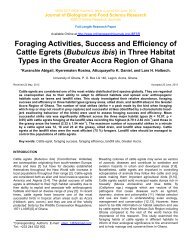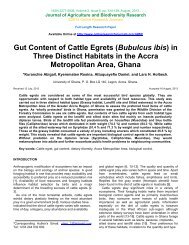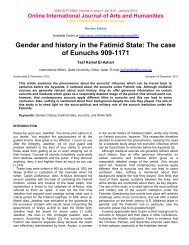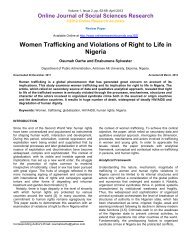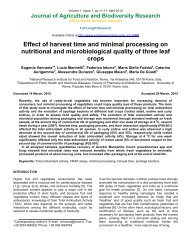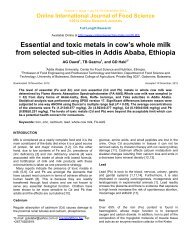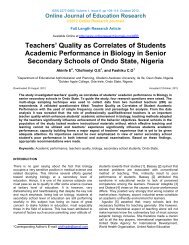Reprint (PDF) - Online Research Journals
Reprint (PDF) - Online Research Journals
Reprint (PDF) - Online Research Journals
Create successful ePaper yourself
Turn your PDF publications into a flip-book with our unique Google optimized e-Paper software.
Table 1. The result of student’s access to Mobile phone (GSM)<br />
is shown below.<br />
GSM access Frequency (N) Percentage (%)<br />
High 68 68<br />
Moderate 20 20<br />
Low 12 12<br />
Total 100 100<br />
Figure 1. GSM access typology.<br />
<strong>Research</strong> Questions<br />
The following research questions were raised in the<br />
study:<br />
1. What is the level of student’s access to Mobile phone<br />
(GSM)?<br />
2. What is the level of student’s academic performance in<br />
some selected subjects?<br />
Hypotheses<br />
Ho1. There is no significant relationship between access<br />
to GSM (mobile phone) and student’s academic<br />
performance.<br />
Ho2. There is no significant difference between the<br />
students’ academic performance of public and private<br />
secondary schools.<br />
METHODOLOGY<br />
The method adopted in this work was a descriptive<br />
survey. The survey method was considered appropriate<br />
for this study because it is used to investigate phenomenon<br />
in their natural setting so as to examine the true nature of<br />
the subject under discussion. The sample of this study<br />
was made up of students of selected secondary schools<br />
Olofinniyi et al. 163<br />
in Osun State. A sample of ten senior secondary schools<br />
were selected from the population using simple random<br />
sampling technique and ten senior secondary school<br />
students in each of the ten secondary schools selected<br />
using purposive sampling techniques spread across the<br />
three senatorial districts of the state. Thus a total of 100<br />
students respondents were used for the study.<br />
A self constructed questionnaire was used in order to<br />
elicit information from senior secondary school students<br />
for the research work. The validity of the instrument was<br />
ensured by four experts, from departments of Educational<br />
Administration and Planning and Guidance and<br />
Counseling. The reliability of the instrument was assured<br />
through a test re-test method which yielded a correlation<br />
co-efficient of 0.68. This was considered reliable enough<br />
for use.<br />
Frequency counts, percentage scores and Pearson<br />
Product Moment of Correlation Coefficient were used to<br />
determine the access of students to GSM usage and their<br />
performance in some selected subjects, and t-test were<br />
used to test for the students’ academic performance.<br />
Data collected were analyzed using statistical package<br />
for social sciences (SPSS).<br />
Definition of Terms<br />
Access to GSM: This implies the level of students’<br />
access to GSM usage including its sources.<br />
Academic performance: The level of students’<br />
academic success in their various subjects.<br />
RESULTS AND DISCUSSION<br />
Question 1: What is the level of student’s access to<br />
Mobile phone (GSM)?<br />
Table 1 and figure 1 shows that 68 percent of the<br />
respondents have access to Mobile phone (GSM), in all<br />
the ten selected senior secondary schools in the study<br />
area. From the data therefore, it is clear that larger<br />
percentage (68%) of students in the senior secondary<br />
schools have high access to GSM. While lower<br />
percentages of 20% and had moderate and low access<br />
respectively.<br />
Question 2: What is the level of Student academic<br />
performance in some selected subjects?<br />
The analysis of academic performance of students are<br />
(table 2 and figure 2) are based on 5 credits and above<br />
as high performance, 4 credits and below as moderate<br />
and low performances respectively.<br />
Table 2 and figure 2 revealed that 68% of the students<br />
had low (poor) performance in their selected subjects<br />
Ho1: There is no significant relationship between students’



